Squeezing blood from a beet
You can’t get blood from a turnip, but you can get blood from a beet. In fact, you have to be careful with beets. They bruise easily despite their tough appearance and release juices from the slightest scratch. Beet juice will stain your clothes and it is very difficult, if not impossible, to remove. Why is this?
The answer is very simple. The cell structure of beets is quite fragile and breaks easily under any kind of pressure, causing leakage. However, boiling fresh beets with the skin greatly reduces this leakage, so this tactic should be considered when preparing beets. For borscht, for example, you want the leaks to produce the gorgeous blood-red color associated with soup, while if served as a garnish, you may want the beets to appear as red as possible.
Be very careful with beet juice when preparing raw beets as a shredded salad garnish. Raw beets in particular ‘bleed a lot’, and since salads are generally prepared in a hurry, it is easier to stain clothing this way.
There is no other vegetable that drips its juices as dramatically and prolifically as beets, although some fruits like plums do. Even the tomato juice is quite clear: it is the pulp that makes the tomato juice turn red. When it comes to root vegetables, beets are really weird. I’m sure juice would make a good dye, although I’ve never heard of that being tasted. It would certainly be a good marinade.
The last word when handling fresh beets is this: with caution. If you’re hosting a party, remember that beet juice will stain the skin on your hands for hours and you won’t be able to wash it off. So if you’re going to shake hands with a lot of people, you might be embarrassed to extend a beet red hand to your guests.
